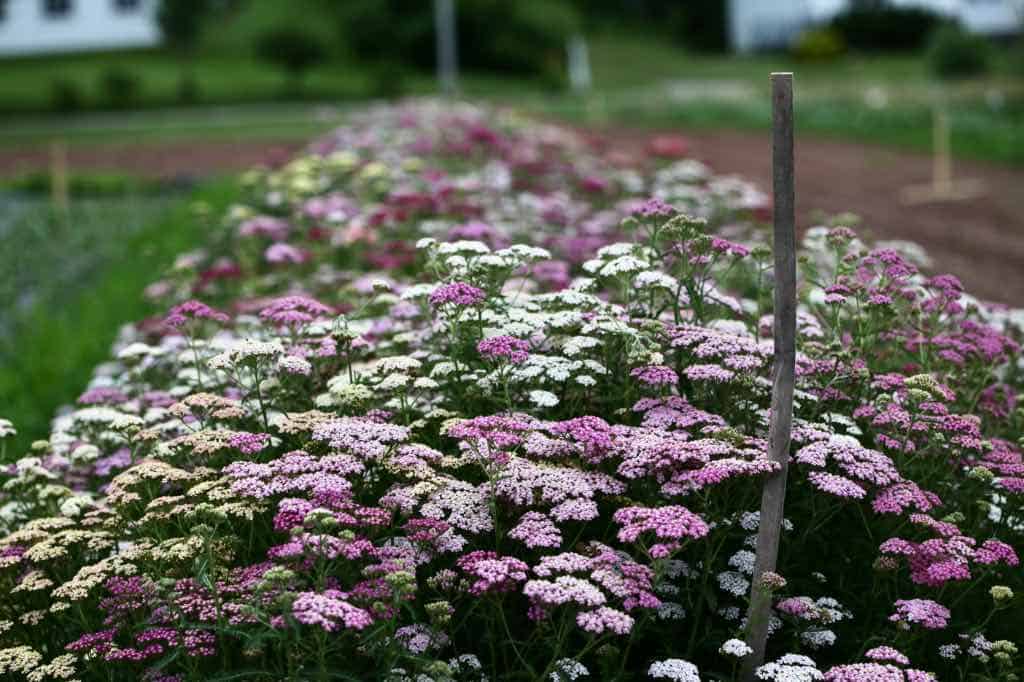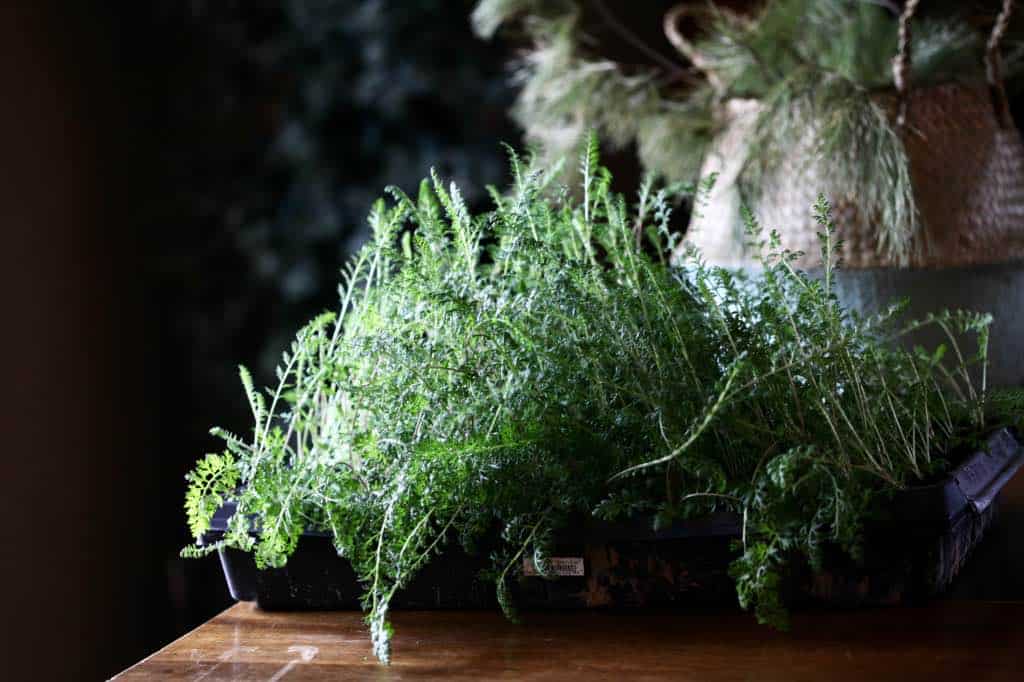There are many things about growing yarrow that we enjoy. This is a wonderful lacey flower for the cutting garden, and a mainstay at our flower farm. Here are some fun facts about yarrow that will make you want to grow it as well!

Yarrow, also known as Achillea millefolium, is a lacy disc shaped flower reminiscent of the cottage garden. It is a common plant growing in many places all over the world, growing in many climates and habitats.It is often referred to as common yarrow.
It is so common in fact, that when we were choosing flowers for the flower farm it was not a plant that I immediately considered. We already had white yarrow growing wildly in our fields with our dandelions. Why would we want to grow it in our cutting garden?
I ordered some seeds of Colorado Mix Yarrow, and decided to grow a small patch of yarrow just to see how it would measure up as a cut flower. I was so pleased with the results that I grew even more the next year. In the second year my first patch of yarrow became even more beautiful as it matured. It was tall and full and quite breath taking!
Needless to say I was happy that I gave it a try!
Here are 5 fun facts about yarrow that will make you want to grow it too!
Yarrow Is Perennial and Comes Back Every Year

When I first planted the Colorado Mix Yarrow I mistakenly thought that it was an annual, since it bloomed in the year it was planted .We planted it into landscape fabric 9 inches apart, in a row about 30 feet long and 30 inches wide. In the fall when the plants died down we removed the landscape fabric.
That winter while reviewing my plant facts I discovered that the yarrow was actually a perennial. So the next spring we kept an eye out for the early spring growth to make sure we didn’t damage it with our tiller. Sure enough it reappeared, and continued to grow into a small hedge of beautiful yarrow.
We live in zone 5b, and the yarrow really did well in our area. It survived multiple spring frosts, and grew exceptionally well throughout the season.
Yarrow Is Easy To Grow From Seed
I started my yarrow seeds in trays inside under grow lights. The seeds were planted on top of the soil since they require light for germination.They grew very well and didn’t require any special care. I had some trays on heat mats the first year, however the second year I noticed that they also germinated well without the bottom heat.

These plants transplanted well into the garden. The first year they were planted into landscape fabric. The next year they were planted into a row without the fabric.There was a lot of weed competition without the fabric and these young seedlings essentially got lost among the weeds! However they still continued to grow.
The yarrow that had been planted in landscape fabric, in the second year of growth, blocked out most of the weeds. I am hoping that my second patch of yarrow, which was not planted in landscape fabric, will come back big and beautiful in it’s second year and knock out all that weed competition! This will be determined this coming growing season.
Yarrow Is Deer Resistant

We have a lot of deer here in Nova Scotia.They love to munch on tender daylily buds, eat the hosta leaves, and walk through our gardens tasting various plants.
They did not touch the yarrow in the garden. Not one plant! I was very happy to discover that yarrow is deer resistant!
Deer do not like to eat plants that have a bitter taste. Yarrow has a bitter and pungent taste, and has been referred to as “poor man’s pepper”. It has been said that if cows eat too much of it in the pasture it can make their milk taste bitter.
Yarrow is strongly scented, which also contributes to the deer repellence.
Bees and Other Pollinators Love Yarrow

We love pollinators, and any plants that they love, we do as well.
Yarrow is a pollinator attractant which makes it perfect for the garden. The disc shaped flower head has a distinctive smell and is covered in tiny daisy like flowers, which the pollinators love. It provides nector and pollen for bees, butterflies, lady bugs and other pollinators.
The dense fernlike foliage is also a habitat for some species.These fine feathery leaves have given yarrow it’s common name “milfoil”, which means a thousand leaves.This is another interesting feature of this plant.
Yarrow Is a Wonderful Dried Flower

Yarrow is an excellent cut flower in it’s fresh form, however can also be cut and dried for use as a dried flower for flower arrangements. It is one of the easiest flowers to dry and looks beautiful in dried arrangements!
Before picking to dry, wait until the flower is fully open and develops it’s pollen.The flower will hold it’s shape better at this stage. You can bundle and hang in a dark warm room. Alternatively the flowers can be left in a vase without water and will dry easily in this location.
I love the look of flowers drying, hanging from the rafters or drying rack in the drying room. This year we will be planting more everlastings and varieties that we can continue to use once the growing season is finished for another year.
I would definitely recommend growing yarrow, not only for it’s beauty but for the multitude of benefits it offers to the garden. It is understated and common, but when you actually spend some time with yarrow, you may develop a deeper appreciation of it’s wonderful benefits and decide to grow it too!

Do you know some fun facts about yarrow that would make someone want to grow it? Be sure to leave a comment below to share your ideas!
OTHER POSTS YOU MAY LOVE:
PIN IT FOR LATER!




